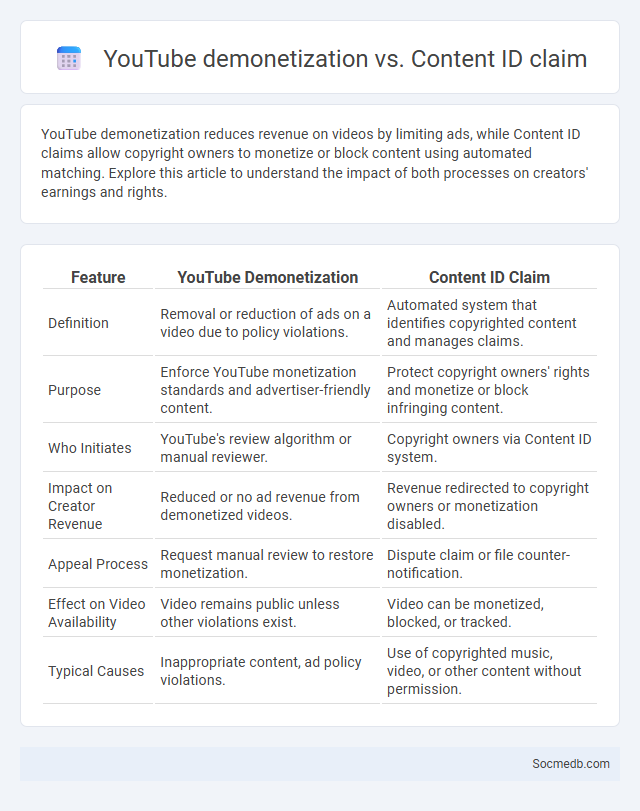
Photo illustration: YouTube demonetization vs content ID claim
YouTube demonetization reduces revenue on videos by limiting ads, while Content ID claims allow copyright owners to monetize or block content using automated matching. Explore this article to understand the impact of both processes on creators' earnings and rights.
Table of Comparison
| Feature | YouTube Demonetization | Content ID Claim |
|---|---|---|
| Definition | Removal or reduction of ads on a video due to policy violations. | Automated system that identifies copyrighted content and manages claims. |
| Purpose | Enforce YouTube monetization standards and advertiser-friendly content. | Protect copyright owners' rights and monetize or block infringing content. |
| Who Initiates | YouTube's review algorithm or manual reviewer. | Copyright owners via Content ID system. |
| Impact on Creator Revenue | Reduced or no ad revenue from demonetized videos. | Revenue redirected to copyright owners or monetization disabled. |
| Appeal Process | Request manual review to restore monetization. | Dispute claim or file counter-notification. |
| Effect on Video Availability | Video remains public unless other violations exist. | Video can be monetized, blocked, or tracked. |
| Typical Causes | Inappropriate content, ad policy violations. | Use of copyrighted music, video, or other content without permission. |
Understanding YouTube Demonetization: Key Concepts
YouTube demonetization occurs when videos fail to meet the platform's advertiser-friendly guidelines, impacting creators' revenue streams from ads. Key factors include content that is violent, sexually explicit, or contains hate speech, leading to restricted ads or removal of monetization. Understanding these policies enables creators to optimize their content for maximum monetization potential while adhering to platform standards.
What is a Content ID Claim?
A Content ID Claim is a digital copyright enforcement tool used by platforms like YouTube to automatically identify and manage copyrighted material in uploaded videos. When a video contains copyrighted content registered in the Content ID system, the copyright owner can claim monetization, block the video, or track its viewership statistics. This system helps protect original creators' rights while allowing platforms to handle vast amounts of user-generated content efficiently.
Demonetization vs. Content ID Claims: Core Differences
Demonetization on social media directly impacts a creator's revenue by restricting ad earnings on specific videos, while Content ID claims identify copyrighted material, allowing rights holders to either monetize, block, or track content usage. Demonetization typically stems from content policy violations or advertiser preferences, whereas Content ID claims arise from automated copyright detection systems targeting protected works. Understanding these distinctions is crucial for creators aiming to manage their content's monetization and comply with copyright regulations efficiently.
Common Reasons for YouTube Demonetization
YouTube demonetization commonly occurs due to content that violates community guidelines, including harmful or inappropriate material such as hate speech or graphic violence. Another frequent reason is copyright infringement, where creators use protected music, video clips, or images without proper licenses. You must ensure your videos comply with YouTube's policies and maintain original or properly licensed content to avoid losing monetization privileges.
How Content ID Claims Impact Monetization
Content ID claims directly affect monetization by identifying copyrighted material in your social media uploads and assigning ad revenue to the rightful owners. If a claim is disputed unsuccessfully, your ability to earn from that content is restricted or disabled, impacting overall earnings. Understanding how Content ID algorithms work helps you manage your uploads and safeguard your monetization potential effectively.
Copyright Strikes vs. Content ID Claims
Copyright Strikes occur when a content owner formally reports unauthorized use of their protected material on platforms like YouTube, potentially leading to video removal or account penalties. In contrast, Content ID Claims automatically identify copyrighted content using digital fingerprinting, allowing You to monetize, track, or block the video without immediate account consequences. Understanding these distinctions is crucial for managing your social media presence and avoiding disruptions.
Appeals Process: Fighting Demonetization and Claims
Creators facing demonetization can initiate an appeals process by submitting a detailed claim review request through the platform's support center, providing evidence to dispute content violations. Effective appeals rely on clearly demonstrating compliance with community guidelines and ad-friendly policies, often requiring screenshots, timestamps, or contextual explanations. Prompt and thorough appeals increase the likelihood of reinstating monetization and protecting revenue streams on social media channels.
Best Practices to Avoid Demonetization
To avoid demonetization on social media platforms, creators should strictly follow platform-specific guidelines on content originality, copyright compliance, and community standards. Using licensed or original music, avoiding sensitive or controversial topics, and providing clear, transparent disclosures can significantly mitigate risks. Consistently monitoring analytics and feedback helps identify potential violations early, ensuring sustained monetization opportunities.
Revenue Distribution: Who Profits from Claims?
Social media platforms generate significant revenue from user-generated content, with a considerable portion flowing to advertisers rather than content creators. You often see revenue distribution heavily skewed, as platforms retain the majority of profits while individual users receive minimal compensation for their contributions. Understanding this imbalance highlights the ongoing debate about fair monetization and claim ownership in digital spaces.
Future Trends: Monetization Policies on YouTube
YouTube's evolving monetization policies prioritize creator sustainability through enhanced revenue-sharing models and expanded eligibility criteria for the YouTube Partner Program. Your content can benefit from the introduction of new ad formats, channel memberships, and Super Chat features designed to diversify income streams. Staying informed about these trends ensures you maximize earnings while complying with platform guidelines.
 socmedb.com
socmedb.com